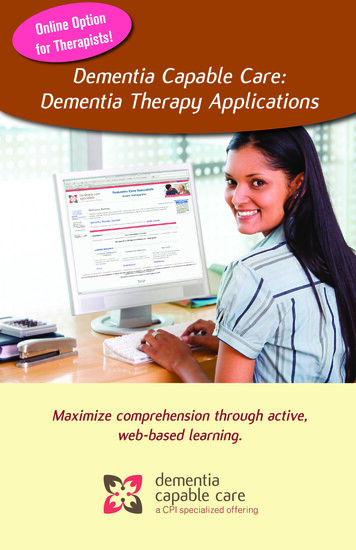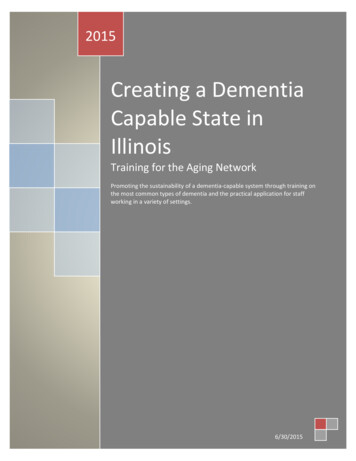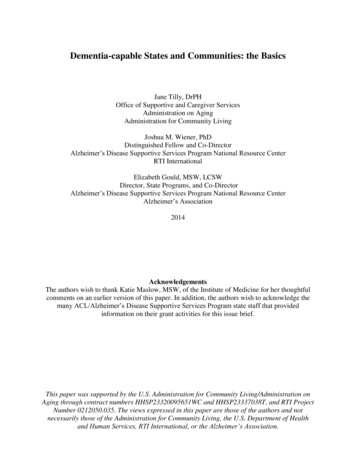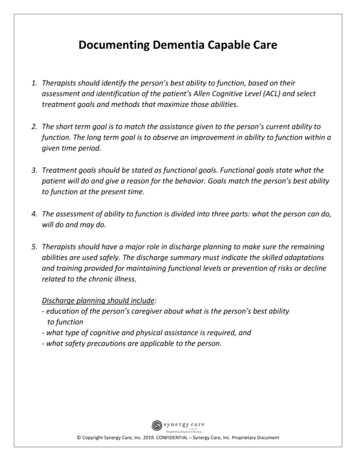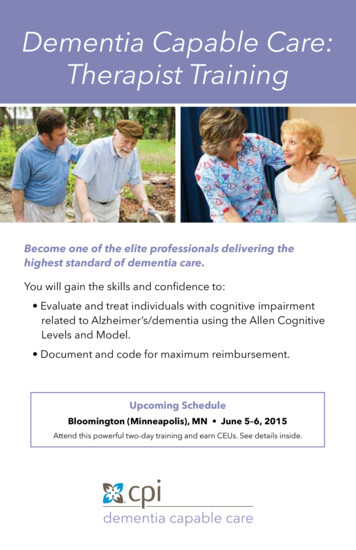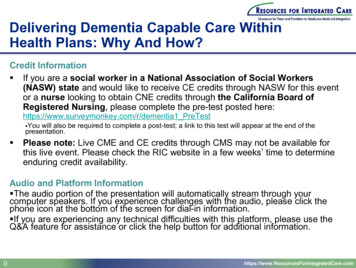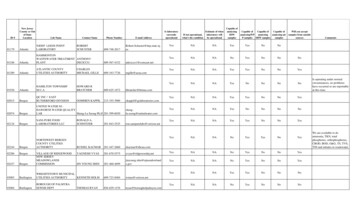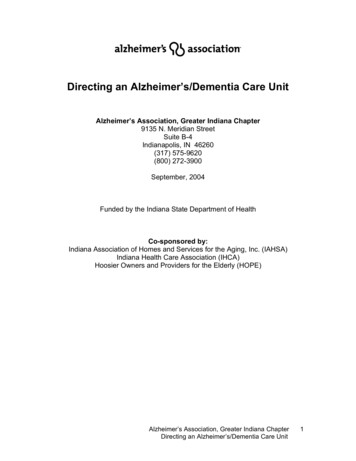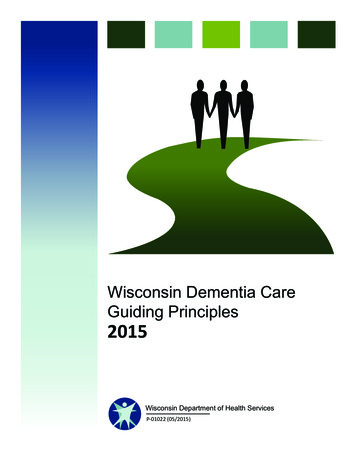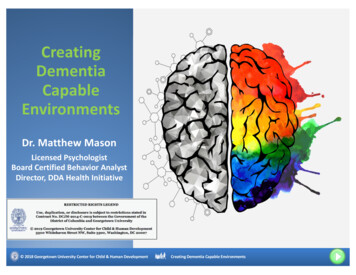
Transcription
CreatingDementiaCapableEnvironmentsDr. Matthew MasonLicensed PsychologistBoard Certified Behavior AnalystDirector, DDA Health Initiative 2018 Georgetown University Center for Child & Human DevelopmentCreating Dementia Capable Environments1
ForwardThe following training was produced by Georgetown University’s Center for Child & HumanDevelopment as part of the the DDA Health Initiative project. This project supports the mission ofthe District of Columbia’s Developmental Disabilities Administration, and focuses on improvingthe physical, behavioral and mental health supports that affect the quality of living for peoplewith intellectual and other disabilities.Except for portions cited, the content of this presentation is copyrighted and protected byGeorgetown University's copyright policies.For questions or additional information on this training and the DDA Health Initiative, or to obtainpermission to reproduce this presentation, please visit our website athttps://ucedd.georgetown.edu/DDA/ or email the Project Director, Dr. Matt Mason, atmam711@georgetown.eduPrevious 2018 Georgetown University Center for Child & Human DevelopmentCreating Dementia Capable EnvironmentsNext2
ObjectivesAt the completion of this training, participants will beable to:1. Define dementia and it’s general impact.2. Identify challenges in identifying dementiaamong people with disabilities.3. Describe strategies to diagnose dementia.4. Describe strategies for creating “dementiacapable” environments. 2018 Georgetown University Center for Child & Human DevelopmentCreating Dementia Capable Environments3
What is Dementia?Dementia is not actually a diagnosis, but rather a catchall phrase that refers to a variety of symptoms. Alzheimer’s Disease is the most common andmost commonly recognized dementia-likediagnosis. Other less known types – but quite commonlyoccurring – include Vascular Dementia, Dementiawith Lewy Body, and Frontotemporal Dementia. 2018 Georgetown University Center for Child & Human DevelopmentCreating Dementia Capable Environments4
Domains SensoryDeficits 2018 Georgetown University Center for Child & Human DevelopmentPlanningDailyLivingCreating Dementia Capable Environments5
Prevalence The global prevalence of dementia is estimated to be between 5% and 7% of adults age 60 An estimated 5.7 million Americans of all ages are livingwith Alzheimer's dementia in 2018.One in 10 people age 65 and older has Alzheimer's.Almost two-thirds of Americans dementia are women.African-Americans are about 2 times more likely to bediagnosed with a dementia.Hispanics are about 1.5 times more likely to bediagnosed with a dementia. 2018 Georgetown University Center for Child & Human DevelopmentCreating Dementia Capable Environments6
People with Disabilities Prevalence rate among people with disabilities is about the same compared to non-disabled peersexcept .People diagnosed with Down Syndrome are athigher risk for early onset and at faster progression.About 22% of people aged about 40 diagnosed withDown Syndrome are also diagnosed with dementia.This number leaps to 65% at about age of 60 People with disabilities are living longer so the rateof a diagnosis of dementia is rising. 2018 Georgetown University Center for Child & Human DevelopmentCreating Dementia Capable Environments7
Cost of Care Average cost of care is about 287,000 per person.Compare this to the cost of heart disease or cancer(about 175,000 per person). For seniors with dementia, the cost of care is about23 times higher than seniors without dementia. Annual cost exceeds 215 billion. 2018 Georgetown University Center for Child & Human DevelopmentCreating Dementia Capable Environments8
Underlying CauseDementia is caused by damage to brain cells. This interferes with the ability of brain cells to communicate with each other. Cognition,behavior and feelings can be affected.The brain has many distinct regions, eachresponsible for different functions. When cells in aparticular region are damaged, that region cannotfunction normally.Damage to brain tissue can vary tremendously inlocation, progression and severity. 2018 Georgetown University Center for Child & Human DevelopmentCreating Dementia Capable Environments9
For Example 2018 Georgetown University Center for Child & Human DevelopmentCreating Dementia Capable Environments10
Neural Cell ChangesWe know some forms of cell changes in the brain areassociated with dementia: There might be fewer cells Plaques, abnormal clusters of protein fragments, can build up between nerve cellsProtein pieces called beta-amyloids can clumptogether and builds up into plaques.Dead or dying nerve cells contain tangles, whichare made up of twisted strands of other proteins 2018 Georgetown University Center for Child & Human DevelopmentCreating Dementia Capable Environments11
Neural Cell Changes We don’t understand why these cell changes occur. We don’t understand how these cell changes causespecific symptoms. We cannot directly observe these changes amongliving people. 2018 Georgetown University Center for Child & Human DevelopmentCreating Dementia Capable Environments12
Diagnosing There isn’t a single test to determine whether dementia is present.We use differential diagnosis to identify dementia,including the medical history, physical exams,laboratory tests, and observing changes in thinking,day-to-day function and behaviors.It is hard to determine the exact type of dementiabecause the symptoms and brain changes ofdifferent dementias can overlap.Development of dementia is not a normal process ofaging. 2018 Georgetown University Center for Child & Human DevelopmentCreating Dementia Capable Environments13
May Look Like Dementia DepressionMedication side effectsExcess use of alcohol or drugsThyroid problemsVitamin deficienciesHearing loss or other sensory changesDehydrationStrokeMalnutritionSleep apnea 2018 Georgetown University Center for Child & Human DevelopmentCreating Dementia Capable Environments14
Cultural & Linguistic Issues Cultural bias play a limiting role in identifying symptoms and impact of dementia.Why are people of color and women more likely tobe diagnosed, but less likely to be identified early?People with a disability are at an even greaterdisadvantage due to how how they may be valued intheir communities tendency to discount therelative impact, less likely to detect due to languageability, less likely to believe accounts.Presence of pre-existing behavioral, cognitive andability limitations among people with disabilities. 2018 Georgetown University Center for Child & Human DevelopmentCreating Dementia Capable Environments15
Dementia Capable Environments1. Requires a stronger focus on screening.2. Broader use of preventative strategies.3. Emphasis on advance planning form in-homesupports and community programs that addressesloss of independence.4. Multi-element cross-disciplinary basis ofcommunity treatment including family support,counseling, medical, behavioral, cognitive care. 2018 Georgetown University Center for Child & Human DevelopmentCreating Dementia Capable Environments16
Words of CautionThere is no cure for dementia. Our focus must be onprevention if possible, and then on quality of life.The greatest difficulty is accepting that their reality ischanging, that we can have a limited impact on thatreality, and that we must join with their reality in orderto find ways to support them. 2018 Georgetown University Center for Child & Human DevelopmentCreating Dementia Capable Environments17
Early Detection Screen for Dementia 2018 Georgetown University Center for Child & Human DevelopmentCreating Dementia Capable Environments18
Differential Diagnosis 2018 Georgetown University Center for Child & Human DevelopmentCreating Dementia Capable Environments19
Possible Protective Strategies1. Diet: Foods with higher levels of anti-oxidants,polyunsaturated fats, and lower calories beneficial.2. Exercise: The universal cure. Obesity is a correlate toincreased risk, along with diabetes.3. Cardiovascular: Hypertension and high blood pressureare added risks, as are high cholesterol.4. Cognitive: Active learning, reading and playing gamesassociated with cognitive “longevity.”5. Social: Although unclear, social networks appear tohave a protective effect against onset of dementia. 2018 Georgetown University Center for Child & Human DevelopmentCreating Dementia Capable Environments20
Medication Not a Cure Cholinesterase inhibitors are prescribed to treatsymptoms related to memory, thinking, language,judgment. Prescribed for early to moderate Alzheimer’s Disease. May delay worsening of symptoms for 6 to 12 months. Examples include Aricept, Namenda, Exelon,Razadyne, Namzaric. Antidepressants may also be useful as a preventativetechnique. 2018 Georgetown University Center for Child & Human DevelopmentCreating Dementia Capable Environments21
Family & Social Supports People with limited social/family networks and low socialengagement may be more likely to develop dementia Social engagement combined with activities such asmovies, clubs, centers, and volunteering may protectagainst cognitive impairment. However, low low social engagement may also be an earlysymptom of cognitive impairment. 2018 Georgetown University Center for Child & Human DevelopmentCreating Dementia Capable Environments22
Complex Social Engagement The interaction between social activity, cognitive activity,and physical activity may also be important. Leisure activities that include cognitive, social, andphysical components might be the best strategy to reducethe risk of cognitive impairment or reduce the rate ofdecline. For people with Intellectual Disability, understanding theirbaseline cognitive and adaptive skills is especiallyimportant. “Diagnostic overshadowing” is a constantconcern. 2018 Georgetown University Center for Child & Human DevelopmentCreating Dementia Capable Environments23
Key Support StrategiesMaintenanceRedirectionLife StoryOrientationValidationAdapted from Habilitation Therapy in Dementia Care. Paul Raia, PhD. 2011. 2018 Georgetown University Center for Child & Human DevelopmentCreating Dementia Capable Environments24
Maintenance Supports Considered best practice in dementia care. Proactive approach can eliminate hours of reaction. Focus is on support of remaining abilities.– Respect the changing needs of the person– Provide meaningful, failure-free activity.– Allow the person to do as much as they can for themselvesbut be aware that as the disease progresses the need forassistance will increase. Can reduce or eliminate difficult behaviors at all stages by reducing frustration, boredom, anxiety, fear, etc.Can be done in all settings by all staff. 2018 Georgetown University Center for Child & Human DevelopmentCreating Dementia Capable Environments25
Redirection Distract and redirect to minimize or avoid outbursts and challenging behaviors.Redirected with gentle distraction or by suggesting adesired activity.Providing food, drink, or rest can be a redirection.Smile, use a reassuring tone. Body language isimportant. 2018 Georgetown University Center for Child & Human DevelopmentCreating Dementia Capable Environments26
Orientation Do not correct or try to reorient the person. The person with dementia may no longer be able to make sense of the present. Lost memories of yearspast will become their new reality and they even mayre-live past events.To avoid frustration and agitation, you must entertheir reality. Don’t argue. This is not lying, it isrespecting their reality. 2018 Georgetown University Center for Child & Human DevelopmentCreating Dementia Capable Environments27
Life StoriesEveryone has a life story that needs to be honored andrespected The story is the essence of each person and should be documented over the lifespan.When a person can no longer tell their ownstory, activities related to storytelling can still beused to inform caregiving and plan activities. 2018 Georgetown University Center for Child & Human DevelopmentCreating Dementia Capable Environments28
ValidationFocuses on empathy and understanding. Based on the general principle the acceptance of the reality and personal truth of a person's experience no matter how confused.Can reduce stress, agitation, and need formedication to manage behavioral challenges.Forcing a person with dementia to accept aspects ofreality that he or she cannot comprehend is cruel.Emotions have more validity then the logic thatleads to them. 2018 Georgetown University Center for Child & Human DevelopmentCreating Dementia Capable Environments29
Challenges Behavioral and emotional outbursts tend to increaseover time, and may not respond to standardbehavioral treatments. Language skills tend to decrease over time. Staff mustbe creative in using non-verbal skills. Sensory and perceptual skills will decline.Environmental modifications will be needed. Memory loss leads to confusion and repetition, withan underlying emotional base of fear, anxiety. 2018 Georgetown University Center for Child & Human DevelopmentCreating Dementia Capable Environments30
And More Challenges inations 2018 Georgetown University Center for Child & Human Development Sleep disruptionSexual disinhibitionResistance to careSensory sensitivityInability to communicate painTactile defensivenessCreating Dementia Capable Environments31
Big Picture The rate of decline and types of changes are highlyvariable we must be responsive to nuanced changesof each person we support. Our behavior and environment must be the focus ofchange and adaptation rather than focusing onchanging the person. It can be a sad experience for staff. Celebrating theperson and the staff must become a focal point or risklosing valued caregivers. 2018 Georgetown University Center for Child & Human DevelopmentCreating Dementia Capable Environments32
References Alzheimer’s Association (2017). 2016 Alzheimer’s Disease Facts and Figures. Alzheimer’s &Dementia, 12(4).Hurd, M. et al. (2013). Monetary costs of dementia in the United States. New England Journalof Medicine, 368: 1326-1334.Knight, R. et al. (2018). A systematic review and meta-analysis of the effectiveness ofacetylcholinesterase inhibitors and memantine in treating the cognitive symptoms ofdementia. Dementia and Geriatric Cognitive Disorders, 45(1).National Task Group on Intellectual Disabilities and Dementia. American Academy ofDevelopmental Medicine and Dentistry. https://aadmd.org/ntgPlassman B. L. et al. (2007) Prevalence of Dementia in the United States: The Aging,Demographics, and Memory Study. Neuroepidemiology. 29(1-2).Prince, M. et al (2013). The global prevalence of dementia: A systematic review and metaanalysis. Alzheimer's & Dementia, (9)1.Raia, P. (2011). Habilitation Therapy in Dementia Care. Age in Action, 26(4). 2018 Georgetown University Center for Child & Human DevelopmentCreating Dementia Capable Environments33
2018 Georgetown University Center for Child & Human Development Creating Dementia Capable En vironments 8 Average cost
